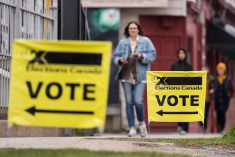Candidates who spent the most money or received the most donations during last fall’s Canadian Wheat Board election didn’t always win, according to the election co-ordinator’s report on election donations and spending.
For example, District 8 incumbent Rod Flaman received $1,698 in donations towards his reelection campaign to the CWB’s board of directors and spent just $1,415.23 – well under the spending cap of $15,000.
David Schnell, who ran second in District 8 with 40 per cent of the votes, received $12,423.77 in donations and spent $13,130.11 on his campaign.
Read Also

The joys of fishing from shore
Manitoba has many lake and river shorelines to drop a fishing line without the cost of a boat, making shore fishing more accessible, and anglers can still catch impressive fish.
Flaman supports retaining the CWB’s single-desk marketing powers; Schnell opposes it.
In District 2, anti-single-desk candidate Jeff Nielsen received 63 per cent of the votes but received just $3,450 in donations. His pro-single-desk opponent, Gerald Pilger received almost $15,000 in donations. Both candidates spent close to $15,000 on their campaigns.
Incumbent pro-single desk District 10 candidate Bill Toews received $9,136.67 in donations, compared to the $10,517.12 one of his anti-single-desk challengers, Curtis Sims, took in. Toews, who won on the first ballot with 54 per cent of the votes, spent $13,310.06 versus $7,217.12 for Sims.
(Rolf Penner’s figures were not reported by the election co-ordinator, but Penner said in an interview he collected $15,116.67 in donations and spent just under $14,000 on his campaign in District 10 (see related story on page 9). The anti-single-desk candidate received 23 per cent of the votes.)
Bill Woods, who took 63.4 per cent of the votes, winning on the first ballot in District 4, coincidentally received the most donations and spent the most: $19,586.49 and $14,900.20, respectively.
One of his challengers, Sam Magnus, received $12,062.43 in donations – including $250 from Gerry Ritz, the federal minister of agriculture.
“As a farmer and a citizen of my district, I supported the candidate who stood for improving the livelihood of farmers,” Ritz said via e-mail.
Although pro-single-desk supporters complained most loudly when the federal government removed the $15,000 spending cap for third-party interveners, it was the pro-single-desk group Real Voice for Choice that spent the most on CWB election advertising: $24,049.16.
While the anti-single-desk National Citizens’ Coalition received $13,683 in donations related to the CWB election, it only spent $3,466.84.
The Western Canadian Wheat Growers Association’s information is not included in the report (see page 9). Association spokesman Blair Rutter said the group received $2,600 in donations, but spent none on CWB election advertising.
The election co-ordinator’s election spending report, which includes the names of those who contributed more than $100, is available from the Canadian Wheat Board’s website under “Hot Topics” at http://www.cwb.ca/public/en/hot/.[email protected]



















